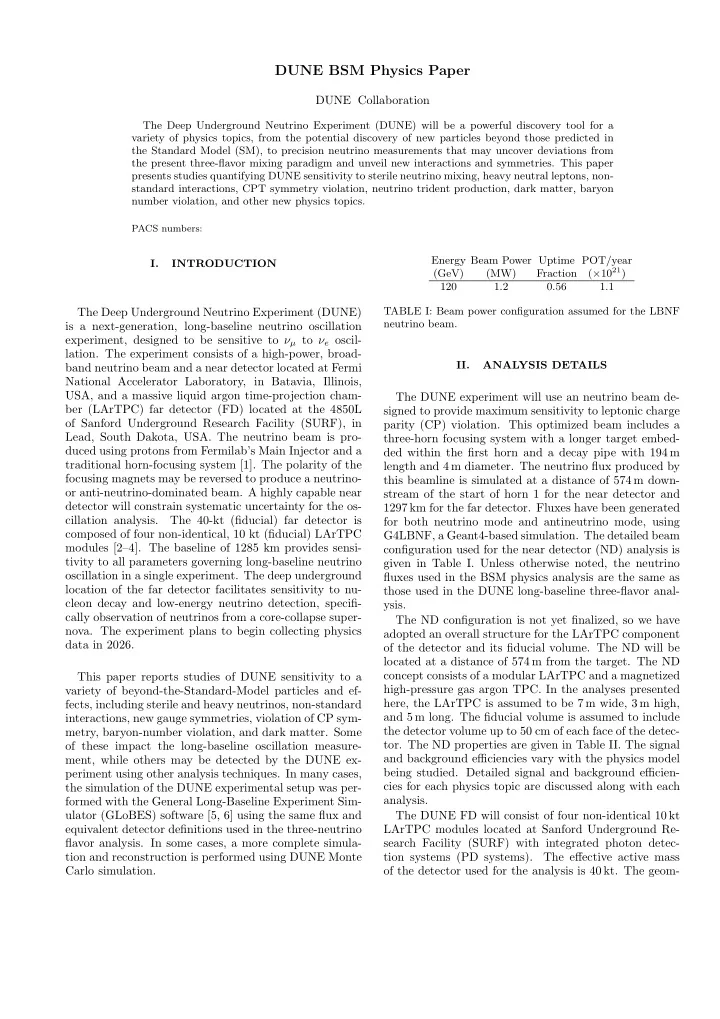

DUNE BSM Physics Paper DUNE Collaboration The Deep Underground Neutrino Experiment (DUNE) will be a powerful discovery tool for a variety of physics topics, from the potential discovery of new particles beyond those predicted in the Standard Model (SM), to precision neutrino measurements that may uncover deviations from the present three-flavor mixing paradigm and unveil new interactions and symmetries. This paper presents studies quantifying DUNE sensitivity to sterile neutrino mixing, heavy neutral leptons, non- standard interactions, CPT symmetry violation, neutrino trident production, dark matter, baryon number violation, and other new physics topics. PACS numbers: Energy Beam Power Uptime POT/year I. INTRODUCTION ( × 10 21 ) (GeV) (MW) Fraction 120 1.2 0.56 1.1 The Deep Underground Neutrino Experiment (DUNE) TABLE I: Beam power configuration assumed for the LBNF neutrino beam. is a next-generation, long-baseline neutrino oscillation experiment, designed to be sensitive to ν µ to ν e oscil- lation. The experiment consists of a high-power, broad- II. ANALYSIS DETAILS band neutrino beam and a near detector located at Fermi National Accelerator Laboratory, in Batavia, Illinois, USA, and a massive liquid argon time-projection cham- The DUNE experiment will use an neutrino beam de- ber (LArTPC) far detector (FD) located at the 4850L signed to provide maximum sensitivity to leptonic charge of Sanford Underground Research Facility (SURF), in parity (CP) violation. This optimized beam includes a Lead, South Dakota, USA. The neutrino beam is pro- three-horn focusing system with a longer target embed- duced using protons from Fermilab’s Main Injector and a ded within the first horn and a decay pipe with 194 m traditional horn-focusing system [1]. The polarity of the length and 4 m diameter. The neutrino flux produced by focusing magnets may be reversed to produce a neutrino- this beamline is simulated at a distance of 574 m down- or anti-neutrino-dominated beam. A highly capable near stream of the start of horn 1 for the near detector and detector will constrain systematic uncertainty for the os- 1297 km for the far detector. Fluxes have been generated cillation analysis. The 40-kt (fiducial) far detector is for both neutrino mode and antineutrino mode, using composed of four non-identical, 10 kt (fiducial) LArTPC G4LBNF, a Geant4-based simulation. The detailed beam modules [2–4]. The baseline of 1285 km provides sensi- configuration used for the near detector (ND) analysis is tivity to all parameters governing long-baseline neutrino given in Table I. Unless otherwise noted, the neutrino oscillation in a single experiment. The deep underground fluxes used in the BSM physics analysis are the same as location of the far detector facilitates sensitivity to nu- those used in the DUNE long-baseline three-flavor anal- cleon decay and low-energy neutrino detection, specifi- ysis. cally observation of neutrinos from a core-collapse super- The ND configuration is not yet finalized, so we have nova. The experiment plans to begin collecting physics adopted an overall structure for the LArTPC component data in 2026. of the detector and its fiducial volume. The ND will be located at a distance of 574 m from the target. The ND concept consists of a modular LArTPC and a magnetized This paper reports studies of DUNE sensitivity to a high-pressure gas argon TPC. In the analyses presented variety of beyond-the-Standard-Model particles and ef- here, the LArTPC is assumed to be 7 m wide, 3 m high, fects, including sterile and heavy neutrinos, non-standard and 5 m long. The fiducial volume is assumed to include interactions, new gauge symmetries, violation of CP sym- the detector volume up to 50 cm of each face of the detec- metry, baryon-number violation, and dark matter. Some tor. The ND properties are given in Table II. The signal of these impact the long-baseline oscillation measure- and background efficiencies vary with the physics model ment, while others may be detected by the DUNE ex- being studied. Detailed signal and background efficien- periment using other analysis techniques. In many cases, cies for each physics topic are discussed along with each the simulation of the DUNE experimental setup was per- analysis. formed with the General Long-Baseline Experiment Sim- ulator (GLoBES) software [5, 6] using the same flux and The DUNE FD will consist of four non-identical 10 kt equivalent detector definitions used in the three-neutrino LArTPC modules located at Sanford Underground Re- flavor analysis. In some cases, a more complete simula- search Facility (SURF) with integrated photon detec- tion and reconstruction is performed using DUNE Monte tion systems (PD systems). The effective active mass Carlo simulation. of the detector used for the analysis is 40 kt. The geom-
Recommend
More recommend